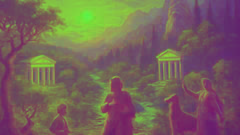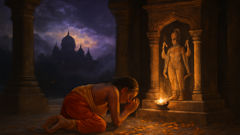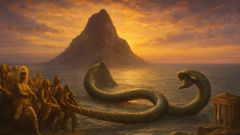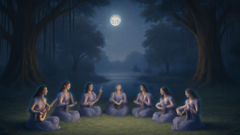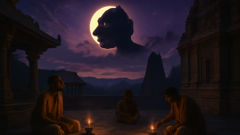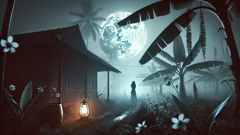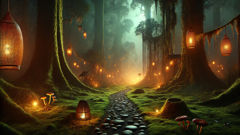Introduction
In the golden heart of ancient Italy, beneath skies that shimmered with the promises of gods and legends, stories were born that still echo in the world's imagination. The Metamorphoses, a tapestry woven from over two hundred and fifty myths, is not just a chronicle of the distant past; it’s a vibrant testament to humanity’s search for meaning in the face of change. It begins before time itself, in a swirling chaos from which the earth, sky, and sea were carved by divine hands. Here, nature is alive and restless, forever in flux, shaped by the passions of capricious gods and the yearning of mortals. Mountains rise where lovers fall, rivers flow from the tears of nymphs, and humble mortals are transformed into stars, trees, or birds—each metamorphosis a spark of eternal memory. In this ancient landscape, power and beauty are both revered and feared, for nothing is fixed and every creature, god or human, is subject to the whims of fate. Through tales of love both tragic and triumphant, of rivalry and revenge, and of heroes whose journeys become the very map of the world, the Metamorphoses invites us to witness how the struggle for meaning and transformation is as old as time itself. As you step into this world—where the marble columns of Rome are mere saplings in the forest of history—you’ll find that every stone, river, and breeze is alive with stories of becoming. Prepare to lose yourself in a universe where the boundaries between nature and humanity blur, and the only constant is change.
The Dawn of Chaos: Birth of the World and the First Transformations
Before the first dawn, before the breath of wind or the whisper of the sea, all was chaos—a boundless, formless mass where earth, air, and water lay entangled, locked in an uneasy embrace. No sun marked the sky, no stars mapped the night. Darkness reigned. Then, from this void, a force awakened—a spirit ancient as the cosmos itself, patient and wise. It began to sort, to untangle, to separate the heavy from the light, the moist from the dry. Earth settled below, solid and silent. Air climbed above, growing light and restless. The waters gathered into vast, whispering oceans. Fire, the wildest of all, soared upwards to ignite the heavens. The world took shape, and with it, the first gods were born: primordial beings who saw themselves reflected in the mountains and rivers, in the restless sky and the fertile fields.
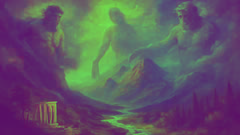
The earth blossomed with forests, meadows, and beasts both gentle and fierce. Rivers danced their way to the sea, carving valleys and feeding the land. The first mortals emerged—simple, fragile, yet filled with curiosity and awe. These early humans lived in harmony with nature; there was no need for law, for justice, or for kings. Their hearts were innocent, and the world itself was a golden age. But perfection is fleeting. Over time, innocence gave way to desire. The gods, watching from their hidden realms, grew restless. Some, like Saturn, ruled with wisdom and a heavy hand; others, like Jupiter, coveted both power and pleasure. The first great transformations unfolded: Lycaon, the arrogant king who dared test the gods with impiety, was turned into a wolf—his body twisted, his voice reduced to a mournful howl. From this act of divine wrath, mortals learned that change could be both punishment and warning.
Nature too was never still. Mountains rose where giants fell, their massive bodies buried beneath the earth. Rivers shifted course at the whim of grieving nymphs or vengeful gods. Even the stars themselves were once beings of flesh and spirit: the Pleiades, sisters pursued and tormented, were lifted to the sky and given new form as a sparkling cluster. In these early days, the boundaries between matter and soul, between earth and heaven, were thin as mist. Everything could be transformed—by love, by loss, by fate’s inscrutable hand.
As the golden age faded, the world moved through silver, bronze, and iron—each era marked by growing hardship and complexity. People learned to build houses and cities, to wage war, to covet wealth. Yet, even as humanity changed, the pulse of nature remained. The gods, ever watchful, continued to shape the fates of mortals and to remind them that nothing in creation is immune to change. The world itself became a tapestry of stories—each stone and tree a silent witness to metamorphosis.
Divine Rivalries: Jupiter’s Reign, Love, and Revenge
As order took root in the world, the gods established their dominion atop Mount Olympus, looking down on mortals with a mixture of fondness and caprice. Jupiter, the thunder-wielding king, ruled with a blend of justice and overwhelming might. His brothers Neptune and Pluto carved their own realms from sea and underworld, while Juno, his queen, presided with a jealousy that burned as fiercely as his lightning.
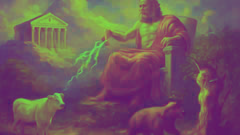
Olympus was a place of feasts and quarrels, alliances and betrayals. The gods were mirrors of human longing and error—grand in power, yet subject to passion’s storm. Jupiter’s heart was famously fickle. His love affairs with mortals and nymphs left trails of wonder and sorrow across the earth. Io, a gentle priestess, caught his wandering eye. To shield her from Juno’s wrath, Jupiter cloaked Io in the shape of a white cow. Juno, suspecting deception, sent a gadfly to torment the poor creature, forcing Io to wander the world until finally, after many trials, she was restored to her human form and honored as a goddess in Egypt.
Not all transformations were so benign. Callisto, a devoted follower of Diana, fell prey to Jupiter’s attention and Juno’s revenge. Changed into a bear, Callisto wandered the forests with her son, who one day raised his spear against her. In pity, Jupiter swept them both into the sky as stars—the Great Bear and Little Bear—forever circling the pole. The heavens thus became a record of divine dramas and mortal suffering.
Love and rivalry shaped countless fates. Daphne, pursued by the lovesick Apollo, called upon her father, a river god, to save her. In answer, her body stiffened and her limbs twisted into branches; she became the first laurel tree, her beauty preserved in green leaves and sweet fragrance. Narcissus, adored by many but loving only himself, was punished by Nemesis: transfixed by his own reflection, he wasted away until he became the delicate flower that still bears his name.
Olympus was never still. The stories of Phaethon, who dared drive the chariot of the sun only to scorch the earth and fall in flames; of Arachne, the proud weaver transformed into a spider by jealous Minerva; and of Actaeon, changed into a stag for glimpsing Diana at her bath—all spoke of the dangers of pride and the limits of mortal ambition. Through each tale, the gods reminded mortals that their powers were vast but their favor fickle. Divine love could elevate a humble maiden to the heavens, or cast down a king with a word. In this world, transformation was both blessing and curse—a way for the gods to mark their whims on the ever-changing tapestry of the earth.
The Power of Love: Tragedy, Devotion, and Nature’s Gifts
Beneath the gaze of gods and heroes, love blossomed in myriad forms—sometimes tender, sometimes tragic, always transformative. The stories of mortals and immortals intertwined, each encounter leaving ripples across the landscape and within the hearts of those touched by passion’s flame.
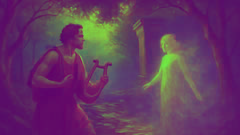
In Thrace, Orpheus, son of Apollo and muse Calliope, wove music so sweet that rivers paused and trees bent to listen. His love for Eurydice was as deep as the sea and as fragile as sunlight. When Eurydice was claimed by a serpent’s bite, Orpheus descended into the realm of shadows, his lyre coaxing tears from even Pluto. The lord of the dead granted Eurydice’s return—but with one cruel condition: Orpheus must not look back until they reached the upper world. Love and longing warred within him, and just as daylight touched his face, he turned. Eurydice faded like mist. In his grief, Orpheus sang to the woods and rocks until he himself was changed, his spirit merging with the music of nature forever.
Elsewhere, Pyramus and Thisbe’s devotion defied even the stone walls that kept them apart. Meeting by moonlight beneath a white mulberry tree, they became victims of tragic misunderstanding—a lion’s bloody jaws convinced Pyramus his beloved was dead. In despair, he fell upon his sword; Thisbe, finding him dying, joined him in death. The gods, moved by their love, forever stained the mulberries red in memory of their sacrifice.
Not all love stories ended in sorrow. Baucis and Philemon, humble and kind, welcomed Jupiter and Mercury disguised as weary travelers. While their neighbors scorned the gods, these two offered bread and shelter. As reward, their simple cottage became a temple, and they themselves were granted a single wish: to die together. In their final moments, they were transformed into intertwined trees—oak and linden—growing side by side at the temple gates, symbols of enduring love and hospitality.
Nature itself often played a role in these tales. Ceyx and Alcyone, separated by stormy seas, were reunited by compassion: the gods transformed them into kingfishers—halcyon birds—so they might always be together over calm waters. In every corner of the world, trees, flowers, and birds carried stories of human longing and divine intervention. These transformations were not punishments, but gifts—ways for love to endure beyond the grave, in roots and wings and petals kissed by sunlight.
Conclusion
From the birth of the world to the rise of Rome’s founders, the Metamorphoses reveals that change is the heart of every story. Mountains and rivers, animals and humans—all are shaped by the hands of gods and the impulses of passion. These tales remind us that nature is alive with memory and meaning. Every laurel tree whispers of Daphne’s flight; every bear constellation marks a mother’s sorrow; every songbird carries the echo of a lost love. In these ancient stories, transformation is both warning and promise—a testament to resilience, beauty, and the mystery at the core of existence. The Metamorphoses endures because it mirrors our own lives: restless, uncertain, always becoming. Through myth, the world becomes a living tapestry where past and present intertwine and where every ending is the seed of new beginnings.

